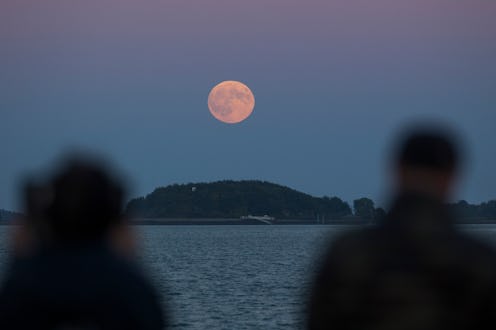Life
Here’s The EXACT Time Of Day You Should Head Out To See January’s Lunar Eclipse

If you have a soft spot for stargazing, chances are you have seen a super moon, at least heard of of a blood moon, and are not even phased (heh) by blue moons anymore. So hold on to your telescopes, and get ready for the ~super blue blood moon~. While the rare celestial event may be too much of a mouthful to inspire a Billie Holliday song, you're going to want to know when to see January 2018's total lunar eclipse.
Why is it so special, you ask? Because a super blue blood moon only occurs when a trifecta of separate lunar phenomena — a blue moon, a super moon, and a blood moon — take place simultaneously. A full moon is called "blue" when it is the second of its kind to be visible during any given calendar month (side note: the name "blue moon" actually stems from the Old English word "belewe" meaning betrayer as it diverges from the traditional 12-month lunar calendar). A super moon takes place when the moon is full and at the closest distance to earth during an elliptical orbit, making it seem a little bit larger (though, truth be told, this is not often apparent to the naked eye.) Finally, the term "blood moon" is used to describe the moon's rusty, blood-like, red appearance as it passes through the earth's shadow.
So, yes, it's a pretty big deal.
While the super blue blood moon is something to be celebrated, chances are you won't be receiving an invite to a watch it with your friends. According to Space.com, the eclipse is set to begin around 6:48 AM EST and 3.48 a.m. PST. The main event — that is totality when the earth's shadow totally covers the moon — will take place around 7:51 AM Eastern Standard Time, TIME reports.
Don't be fooled if the times it will be visible on the east coast seem slightly more conducive to watching, it should be noted they also coincide with the approximate time the moon will set for the day, giving viewers on the west coast the upper hand.
Space, in particular astronomical events, have captured the attention and sparked the imagination of humans for as long as they have taken place. You may remember last summer's "Great American Solar Eclipse," the last astronomical event to capture the country's attention. People made their own viewing glasses, threw parties, and drove across the country to catch a glimpse of the path of totality anywhere between South Carolina and Oregon. The event taking place tomorrow is, in some ways, not wholly unlike last year's solar eclipse. A solar eclipse occurs when the moon sits between the earth and the sun, thereby blocking part of, or the entire sun from view. The difference is that nothing blocks the view of the moon during a lunar eclipse, it simply appears darker due to the way it is being hit by the earth's shadow.
The super blue blood moon is bound the be an amazing spectacle. You can use this nifty little computer to help determine when exactly when you can see the super blue blood moon where you live. But if you can't catch it this time around, don't sweat it too much. Watching an eclipse take place is hardly a once-in-a-lifetime event. Though the super blue blood moon is the first of its kind to occur in the Americas since 1866, a blue moon total eclipse previously took place on December 30, 1982.
So, gather your binoculars and set your alarm to wake you a little earlier tomorrow morning because, in less than 24 hours, there will be blood (moon).